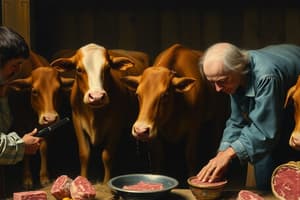Podcast
Questions and Answers
What is the primary method of growing fruits, vegetables, and flowers?
What is the primary method of growing fruits, vegetables, and flowers?
- Aquaculture
- Pastoralism
- Agriculture
- Horticulture (correct)
Grains are seeds of grasses used to make bread, pasta, and cereals.
Grains are seeds of grasses used to make bread, pasta, and cereals.
True (A)
What is the term for farming fish and other aquatic animals?
What is the term for farming fish and other aquatic animals?
Aquaculture
Animals that eat both plants and animals are called ____________________.
Animals that eat both plants and animals are called ____________________.
Which of the following is an example of an animal-based food?
Which of the following is an example of an animal-based food?
Dairy products come from mammary glands of male mammals.
Dairy products come from mammary glands of male mammals.
Match the following foods with their respective categories:
Match the following foods with their respective categories:
Which of the following is an example of a fungi-based food?
Which of the following is an example of a fungi-based food?
All terrestrial foods are plant-based.
All terrestrial foods are plant-based.
What is the term for an animal that eats decaying organic matter?
What is the term for an animal that eats decaying organic matter?
Animals that eat both plants and animals are called ____________________.
Animals that eat both plants and animals are called ____________________.
Match the following animals with their eating habits:
Match the following animals with their eating habits:
Which of the following is an example of an aquatic food?
Which of the following is an example of an aquatic food?
Flashcards are hidden until you start studying
Study Notes
Food Origin
Food Production
- Food production involves the growing, harvesting, processing, and distribution of food
- There are several methods of food production:
- Agriculture: growing crops and raising livestock
- Horticulture: growing fruits, vegetables, and flowers
- Aquaculture: farming fish and other aquatic animals
- Pastoralism: raising livestock on grazing land
Identify Variety of Food
- Fruits: grown on trees or bushes, sweet or tart in taste (e.g. apples, bananas, oranges)
- Vegetables: grown underground or above ground, savory in taste (e.g. potatoes, carrots, broccoli)
- Grains: seeds of grasses, used to make bread, pasta, and cereals (e.g. wheat, rice, oats)
- Proteins: come from animals, include meat, poultry, fish, and dairy products (e.g. beef, chicken, salmon, milk)
- Dairy: produced from mammary glands of female mammals (e.g. milk, cheese, yogurt)
Understand the Different Sources of Food
- Plant-based: food from plants, including fruits, vegetables, grains, and legumes
- Animal-based: food from animals, including meat, poultry, fish, dairy, and eggs
- Microorganism-based: food from microorganisms, such as yeast (e.g. bread, beer), algae (e.g. seaweed), and bacteria (e.g. yogurt, cheese)
Classify Animals Based on Eating Habits
- Herbivores: eat plants and plant-based foods (e.g. cows, deer, rabbits)
- Carnivores: eat animals and animal-based foods (e.g. lions, tigers, wolves)
- Omnivores: eat both plants and animals (e.g. humans, bears, pigs)
- Detritivores: eat dead plants and animals (e.g. vultures, hyenas, earthworms)
Food Origin
Food Production
- Food production involves four stages: growing, harvesting, processing, and distribution
- Four methods of food production: agriculture, horticulture, aquaculture, and pastoralism
- Agriculture involves growing crops and raising livestock
- Horticulture involves growing fruits, vegetables, and flowers
- Aquaculture involves farming fish and other aquatic animals
- Pastoralism involves raising livestock on grazing land
Food Classification
Fruits and Vegetables
- Fruits are grown on trees or bushes and are sweet or tart in taste
- Examples of fruits: apples, bananas, oranges
- Vegetables are grown underground or above ground and are savory in taste
- Examples of vegetables: potatoes, carrots, broccoli
Grains and Proteins
- Grains are seeds of grasses used to make bread, pasta, and cereals
- Examples of grains: wheat, rice, oats
- Proteins come from animals and include meat, poultry, fish, and dairy products
- Examples of proteins: beef, chicken, salmon, milk
Dairy and Microorganism-Based Foods
- Dairy products are produced from mammary glands of female mammals
- Examples of dairy products: milk, cheese, yogurt
- Microorganism-based foods are produced from microorganisms
- Examples of microorganism-based foods: yeast (bread, beer), algae (seaweed), bacteria (yogurt, cheese)
Eating Habits of Animals
Herbivores and Carnivores
- Herbivores eat plants and plant-based foods
- Examples of herbivores: cows, deer, rabbits
- Carnivores eat animals and animal-based foods
- Examples of carnivores: lions, tigers, wolves
Omnivores and Detritivores
- Omnivores eat both plants and animals
- Examples of omnivores: humans, bears, pigs
- Detritivores eat dead plants and animals
- Examples of detritivores: vultures, hyenas, earthworms
Food Classification
- Food can be categorized based on its origin into:
- Plant-based foods: fruits, vegetables, grains, legumes, nuts, and seeds
- Animal-based foods: meat, poultry, fish, eggs, dairy products, and honey
- Fungi-based foods: mushrooms and truffles
- Microorganism-based foods: yeast, yogurt, and fermented foods
Food Sources
- Food sources can be classified into three main categories:
- Terrestrial foods: land-based foods, including plants, animals, and fungi
- Aquatic foods: water-based foods, including fish, shellfish, and seaweed
- Aerial foods: air-based foods, including honey and bird eggs
Animal Eating Habits
- Animals can be classified into different categories based on their eating habits:
- Herbivores: plant-eating animals, such as cows, deer, and rabbits
- Carnivores: meat-eating animals, such as lions, tigers, and bears
- Omnivores: animals that eat both plants and animals, such as humans, pigs, and bears
- Detritivores: animals that eat decaying organic matter, such as earthworms and maggots
- Piscivores: fish-eating animals, such as sharks and fish-eating birds
- Insectivores: insect-eating animals, such as frogs and lizards
- Fungivores: fungus-eating animals, such as snails and slugs
Studying That Suits You
Use AI to generate personalized quizzes and flashcards to suit your learning preferences.




